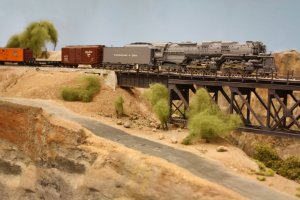Ideally, you would do this work from the original file. The better the source, the better your results will be. Work in high resolution, shoot in RAW if you can. Don't scale your image down until you're ready to export it to the web. Working on the large image will keep plenty of details and help you blend things together.
Even so, this will give you a good idea. Everything was done in Photoshop, since it's what I use and know. There is one tool in Photoshop (and Photoshop Elements too) that really does well with this stuff. It's called "Content Aware Fill". This is a healing brush that scans the adjacent areas and tries to blend in the fill to match. It usually, but not always, does a really nice job of it. I used it extensively on this one, and had the whole thing done in about 10 minutes.
I used the clone stamp to copy and paste some items to new areas, then content aware fill was used to blend and patch as needed. Here's the final result:

This gives you a good idea of what you can do in "post production" (editing). Ideally, you'll do as much as you can "in camera" (when you shoot the photo). As an example, if you have permission, momentarily removing the cop car from the scene would save effort and make that area look better.
Some things can't be fixed in camera, or at least not easily. It's not practical to build more rock wall to hide the benchwork just for a photo. Hiding the wall would be tough easier, as you'd need big screen, and if you use something like a sheet or blanket, it's going to wrinkle and cause problems.
On the other hand, for shots like the turntable, where you could put a sheet of posterboard in, that's a good option. Trying to edit around all the fine details is painstakingly difficult. Ideally, position the train so that the background directly behind it won't need editing.
Even so, this will give you a good idea. Everything was done in Photoshop, since it's what I use and know. There is one tool in Photoshop (and Photoshop Elements too) that really does well with this stuff. It's called "Content Aware Fill". This is a healing brush that scans the adjacent areas and tries to blend in the fill to match. It usually, but not always, does a really nice job of it. I used it extensively on this one, and had the whole thing done in about 10 minutes.
I used the clone stamp to copy and paste some items to new areas, then content aware fill was used to blend and patch as needed. Here's the final result:

This gives you a good idea of what you can do in "post production" (editing). Ideally, you'll do as much as you can "in camera" (when you shoot the photo). As an example, if you have permission, momentarily removing the cop car from the scene would save effort and make that area look better.
Some things can't be fixed in camera, or at least not easily. It's not practical to build more rock wall to hide the benchwork just for a photo. Hiding the wall would be tough easier, as you'd need big screen, and if you use something like a sheet or blanket, it's going to wrinkle and cause problems.
On the other hand, for shots like the turntable, where you could put a sheet of posterboard in, that's a good option. Trying to edit around all the fine details is painstakingly difficult. Ideally, position the train so that the background directly behind it won't need editing.
Last edited by a moderator:

